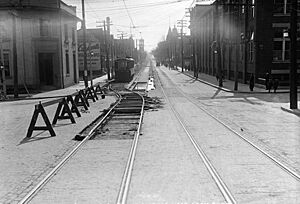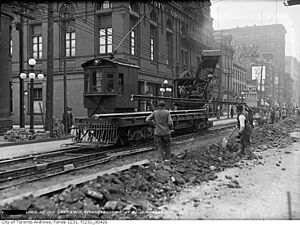History of the Toronto Transit Commission facts for kids
The story of public transportation in Toronto, Canada, began in the mid-1800s. Back then, many different private companies owned and ran the transit systems. But in the 1920s, all these separate companies were brought together under one big government-run organization. This made public travel much more organized for everyone in Toronto.
Contents
Early Days of Toronto Transit
Before the Toronto Transit Commission (TTC) was created, many different companies helped people get around Toronto.
Private Transit Companies
Toronto's very first public transit company was the Williams Omnibus Bus Line. It started in 1849 and was owned by Burt Williams. This company used horse-drawn buses, like big stagecoaches, to carry people. They traveled along King and Yonge Streets, from the St. Lawrence Market to a village called Yorkville. A trip cost six pence, which was a small amount of money back then.
In 1861, a new company called the Toronto Street Railway (TSR) took over. They were given permission to run streetcars for 30 years. When their time was up in 1891, the city tried to run the transit for a few months. Then, another company, the Toronto Railway Company (TRC), got the job. The TRC had to switch from horse-drawn streetcars to electric ones by 1894.
At first, streetcars could only run six days a week because of an old law that banned them on Sundays. People voted on this law in 1892 and decided to keep it. But in 1897, they voted again, and the law was changed. The first Sunday streetcars started running on May 16, 1897.
Outside the main city, other transit lines helped people travel to nearby towns. These were called "radial railways" because their lines spread out like spokes from the city. Some examples were the Toronto and York Radial Railway and the Toronto Suburban Railway.
Public Transit Begins
Before the TTC was formed, the City of Toronto started its own transit system called the Toronto Civic Railways (TCR). This was to serve areas that the private Toronto Railway Company didn't reach.
In 1920, a new law created the Toronto Transportation Commission (TTC). When the TRC's contract ended in 1921, the TTC took over all nine existing transit systems in the city. This brought all public transportation under one management. Between 1921 and 1953, the TTC added many new routes and extended others.
The Great Depression in the 1930s and World War II in the 1940s made things tough for cities to pay for services. But the TTC still worked to improve transit. In 1936, they bought the first modern PCC streetcars. During the war, more people used public transit because gasoline was limited. Toronto kept buying PCC streetcars and ended up with the largest fleet in the world. Many of these were bought used from U.S. cities that stopped using streetcars.
The Toronto Transit Commission (TTC)
How the TTC Was Created
In 1953, leaders decided that public transit was a very important service for the new Metropolitan Toronto area. So, on January 1, 1954, the Toronto Transportation Commission was renamed the Toronto Transit Commission. It became the main organization in charge of public transit for the whole Metro Toronto area. The TTC took over all the old transit companies and four independent bus lines in the suburbs. By 1954, the TTC was the only provider of public transportation in Metro Toronto.
The Subway Boom: 1954–1980
Canada's first subway system was built in Toronto. It was the Yonge Street subway line, running from Union Station to Eglinton. This subway was paid for with money earned during World War II, when many people used public transit.
After five years of construction, the subway opened on March 30, 1954. The underground parts were built using a method called "cut-and-cover." This meant digging a trench, building the tunnel, and then covering it up. Temporary streetcar tracks were laid over the trenches so Yonge Street could stay open.
The first subway line went from Union Station in downtown Toronto north to Eglinton Avenue. Important people like the Premier of Ontario and the Mayor of Toronto rode the first train. That same day, the last streetcar traveled down Yonge Street south of Eglinton. The subway cut the travel time from Union to Eglinton from about 30 minutes by streetcar to less than 15 minutes.
This subway line was the first to completely replace surface streetcar routes. It also helped Toronto become a leader in using aluminum subway cars, which are now common in many transit systems. Since 1954, the subway system has grown a lot, adding new lines and reaching more areas.
Nine years later, the University line opened. It continued north from Union Station under University Avenue to St. George station. This line was designed to help handle more passengers, especially for the planned east-west line.
Three years after that, the original Bloor–Danforth line was built. It ran under Bloor Street and Danforth Avenue, from Keele in the west to Woodbine in the east. Within two years, this line was extended even further, to Islington in the west and Warden in the east.
There were plans for a streetcar subway along Queen Street, which later became a full subway plan in 1964. However, only an unfinished station structure under Queen station was ever built. This Queen Subway plan was canceled in 1974 to focus on new lines in the suburbs.
In the 1970s, Toronto considered getting rid of streetcars. The idea was to use buses for less busy routes and subways for busy ones. But later, because subway construction was so expensive and buses had limits, this decision was changed. Toronto is now one of the few North American cities that still uses streetcars, and it's even expanding the service.
In 1973, the Yonge subway line was extended north to York Mills Road, and then to Finch Avenue the next year. Five years later, the Spadina line opened, going from the north end of the University line to Wilson station. In 1980, the Bloor–Danforth line was extended again to its current ends at Kipling station in the west and Kennedy station in the east.
Slower Growth: 1980–1998
After the Bloor–Danforth line was extended in 1980, subway building slowed down a lot. For the next 16 years, no new subway extensions were built. Instead, a planned extension of the Bloor–Danforth line became the L-shaped Scarborough RT line in 1985. This line ran from Kennedy to McCowan station. It was originally meant to be a light rail line, but it ended up being built like a mini-subway. Two years later, a new station called North York Centre was added on the Yonge line.
In 1985, the TTC released a big plan called Network 2011. It proposed almost doubling the size of the subway system, including new lines on Sheppard, Eglinton, and a Downtown Relief Line. However, only a small part of this plan was ever built. In 1995, the provincial government stopped work on the Eglinton line, and the tunnels that had been dug were filled in. A similar line, Line 5 Eglinton, is now being built. The only subway expansion during this period was on the Spadina line, which added one new station, Downsview (now Sheppard West), in 1996.
Since 1998
In 1998, the separate municipalities that made up Metro Toronto joined together to form the new City of Toronto. Four years later, in 2002, the Sheppard line opened. This was the first new subway line in decades. However, it was much shorter than planned, only going from Yonge Street east to Don Mills Road. The TTC still hopes to extend the Sheppard line if they get the money. Even though it's shorter, the stations were built to handle longer trains in the future.
In 2005, the TTC faced money problems and decided to look for cheaper ways to expand transit. This included ideas like busways (special bus lanes) or expanding the streetcar system with modern vehicles. While the TTC didn't have money for new projects, they did finish planning for an extension of the Spadina line north to York University and Vaughan Metropolitan Centre. This project was completed in December 2017.
On May 29, 2006, TTC employees went on a sudden strike, mainly because of safety worries and late shifts. The strike was quickly declared illegal, and workers were ordered back to work. Even though it was short, it caused big problems in the city on a very hot day. The strike also led to the general manager, Rick Ducharme, resigning a week later.
Another transit strike was avoided in April 2008 when a temporary agreement was reached. However, the TTC union later voted against this agreement, and a strike officially began on April 26, 2008. The provincial government quickly passed a law to send the TTC workers back to their jobs on April 27, 2008.
In 2023, Line 3 Scarborough was permanently closed. It had been in use for about ten years longer than it was designed to last.
Today, the TTC is still the main provider of public transit within the City of Toronto. It also runs some services into the nearby York Region. Other regional transit systems, like GO Transit, and buses from Mississauga, Brampton, York Region, and Durham Region, also connect with Toronto's transit network.
TTC Leaders
The TTC has had many leaders over the years. From 1989 to 1997, the person in charge of the TTC (the "chair") was a member of the Metro Toronto Council. After 1997, the chair was a member of the new City of Toronto Council.
(Chief general managers from 1975)
** denotes general managers for operations
Jaye Robinson Jon Burnside Jamaal Myers
| Name | Term |
|---|---|
| P. W. Ellis | 1920–1929 |
| Frederick Langdon Hubbard | 1929–1930 |
| William C. McBrien | 1931–1932 |
| S.J. McMaster | 1932–1933 |
| William C. McBrien | 1933–1954 |
| William G. Russell | 1954–1955 |
| Allan A. Lamport | 1955–1959 |
| Charles A. Walton | 1959–1960 |
| C. C. Downey | 1960–1963 |
| Ralph Day | 1963–1972 |
| Franklin I. Young | 1972–1973 |
| Karl L. Mallette | 1973–1975 |
| G. Gordon Hurlburt | 1975–1979 |
| Julian Porter | 1979–1987 |
| Jeff Lyons | 1987–1989 |
| Lois Griffin | 1989–1992 |
| Michael (Mike) Colle | 1992–1994 |
| Paul Christie | 1994–1998 |
| Howard Moscoe | 1998–2000 |
| Brian Ashton | 2000–2002 |
| Betty Disero | 2002–2003 |
| Howard Moscoe | 2003–2006 |
| Adam Giambrone | 2006–2010 |
| Karen Stintz | 2010–2014 |
| Maria Augimeri | 2014 |
| Josh Colle | 2014–2018 |
| 2019–2022 | |
| 2022–2023 | |
| 2023–present |
Here is a list of the General Managers and Chief Executive Officers (CEOs) of the TTC:
- Herbert Henry Couzens, General Manager (GM) 1921–1924
- David William Harvey, GM 1924–1938
- Henry C. Patten, GM 1938–1952
- W. E. P. Duncan, GM 1952–1959
- John G. Inglis, General Manager – Operations (GMO) 1959–1968
- James H. Kearns, GMO 1968–1975
- R. Michael Warren, Chief General Manager (CGM) 1975–1981
- Alf Savage, CGM 1981–1987
- Al Leach, CGM 1987–1995
- David L. Gunn, CGM 1995–1999
- Rick Ducharme, CGM 1999–2006
- Gary Webster, CGM 2006–2012
- Andy Byford, acting CGM and Chief Executive Officer (CEO) 2012–2017
- Rick Leary, interim CEO (2017); CEO 2018–present



